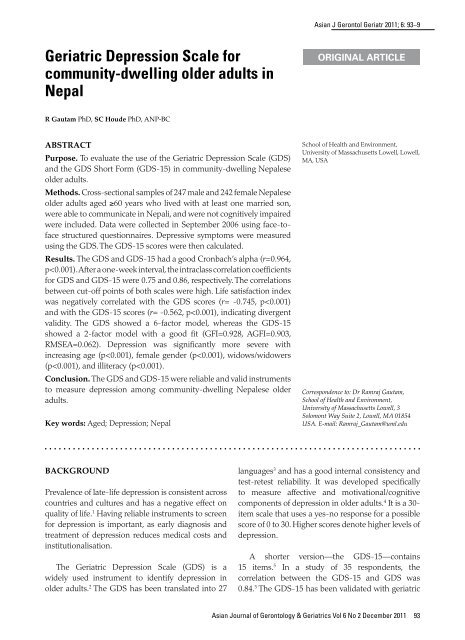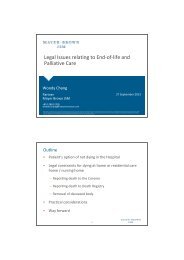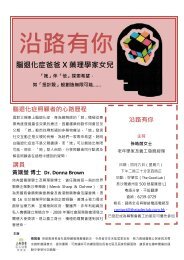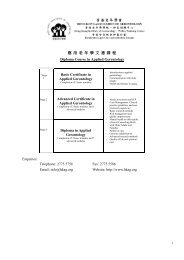Geriatric Depression Scale for community-dwelling older adults in ...
Geriatric Depression Scale for community-dwelling older adults in ...
Geriatric Depression Scale for community-dwelling older adults in ...
Create successful ePaper yourself
Turn your PDF publications into a flip-book with our unique Google optimized e-Paper software.
Asian J Gerontol Geriatr 2011; 6: 93–9<strong>Geriatric</strong> <strong>Depression</strong> <strong>Scale</strong> <strong>for</strong><strong>community</strong>-<strong>dwell<strong>in</strong>g</strong> <strong>older</strong> <strong>adults</strong> <strong>in</strong>NepalORIGINAL ARTICLER Gautam PhD, SC Houde PhD, ANP-BCABSTRACTPurpose. To evaluate the use of the <strong>Geriatric</strong> <strong>Depression</strong> <strong>Scale</strong> (GDS)and the GDS Short Form (GDS-15) <strong>in</strong> <strong>community</strong>-<strong>dwell<strong>in</strong>g</strong> Nepalese<strong>older</strong> <strong>adults</strong>.Methods. Cross-sectional samples of 247 male and 242 female Nepalese<strong>older</strong> <strong>adults</strong> aged ≥60 years who lived with at least one married son,were able to communicate <strong>in</strong> Nepali, and were not cognitively impairedwere <strong>in</strong>cluded. Data were collected <strong>in</strong> September 2006 us<strong>in</strong>g face-tofacestructured questionnaires. Depressive symptoms were measuredus<strong>in</strong>g the GDS. The GDS-15 scores were then calculated.Results. The GDS and GDS-15 had a good Cronbach’s alpha (r=0.964,p
Gautam and Houde<strong>in</strong>patients, 6 outpatients, 7 primary care patients, 8 and<strong>community</strong>-<strong>dwell<strong>in</strong>g</strong> <strong>older</strong> <strong>adults</strong>. 9 The GDS-15 isan adequate substitute <strong>for</strong> the GDS to screen <strong>for</strong> latelife depression, 10 and has good <strong>in</strong>ternal consistencyreliability and an acceptable criterion-relatedvalidity. 11 It has been used to measure depressionamong <strong>community</strong>-<strong>dwell<strong>in</strong>g</strong> <strong>older</strong> <strong>adults</strong> <strong>in</strong> Asiancountries. 12Establish<strong>in</strong>g the reliability and validity of<strong>in</strong>struments to measure depression <strong>in</strong> develop<strong>in</strong>gcountries is needed. 13 This study aimed to evaluatethe use of the GDS and GDS-15 among <strong>community</strong><strong>dwell<strong>in</strong>g</strong><strong>older</strong> <strong>adults</strong> <strong>in</strong> Nepal. The GDS wasadm<strong>in</strong>istered to Nepali <strong>older</strong> <strong>adults</strong> and the GDS-15scores were calculated from the orig<strong>in</strong>al GDS. 14 Thereis a need <strong>for</strong> the shortened version of the GDS. 15METHODSThis cross-sectional study used a face-to-facestructured questionnaire, based on data collectedfrom a survey that exam<strong>in</strong>ed <strong>in</strong>tergenerationalrelationships between <strong>older</strong> <strong>adults</strong> and their marriedsons <strong>in</strong> Nepal. 16 Data were collected by 10 researchers<strong>in</strong> September 2006.Persons aged ≥60 years who lived with at least onemarried son, were able to communicate <strong>in</strong> Nepali,and were not cognitively impaired were <strong>in</strong>cluded.Only one <strong>older</strong> adult from each household wasselected based on their will<strong>in</strong>gness to participate.Of 1539 persons aged ≥60 years <strong>in</strong> a populationof >25 000, 92 were un-contactable, 43 refused toprovide data, 332 were not liv<strong>in</strong>g with a married son,86 refused to participate, 101 could not communicatewell <strong>in</strong> Nepali, 58 term<strong>in</strong>ated the <strong>in</strong>terview, and 338had >1 <strong>older</strong> adult <strong>in</strong> the household. The rema<strong>in</strong><strong>in</strong>g247 men and 242 women (mean±SD age, 69.9±8.1years) were successfully <strong>in</strong>terviewed.This study was approved by The InstitutionalReview Board of the Graduate School of Medic<strong>in</strong>e,University of Tokyo and the Kathmandu Municipalityoffice. Verbal <strong>in</strong><strong>for</strong>med consent was obta<strong>in</strong>ed fromeach participant. Participants could withdraw fromthe <strong>in</strong>terview at any time.The GDS was translated <strong>in</strong>to Nepali fromEnglish by the first author. It was reviewed by 3Nepali graduate students at the University of Tokyo,Japan. It was then back translated <strong>in</strong>to English by aprofessional Nepali-English translator. All versionswere checked <strong>for</strong> any differences and were correctedby the first author. Pilot test<strong>in</strong>g was conducted ona sample of 50 Nepali <strong>older</strong> <strong>adults</strong>. Descriptivestatistics from the pilot study and the feedback fromthe <strong>in</strong>terviewee and <strong>in</strong>terviewers were used to reviseand f<strong>in</strong>alise the questionnaire. Test-retest reliabilitywas conducted with 10 <strong>older</strong> <strong>adults</strong> after a one-week<strong>in</strong>terval.Descriptive statistics and the gender distributionof depression were analysed. T-tests or ANOVAwere conducted <strong>for</strong> patient age, gender, maritalstatus, literacy, as well as GDS and GDS-15 scores.The <strong>in</strong>ternal consistencies of the GDS and GDS-15 were computed with Cronbach alpha reliabilitycoefficients. Divergent validity was evaluated bycorrelat<strong>in</strong>g the scores on the life satisfaction <strong>in</strong>dex(Nepali version) 17 with the GDS-15 and the GDSscores. Severity of depression was analysed us<strong>in</strong>g thewidely used cut-off scores <strong>for</strong> levels of depression ofthe GDS and GDS-15. Levels of depression betweenthe GDS and GDS-15 were correlated. Intraclasscorrelation coefficients were calculated <strong>for</strong> test-retestreliabilities. Exploratory factor analysis was used toanalyse the construct validity of the GDS-30 andGDS-15.RESULTS54% of the respondents were married, 46% werewidowed, and 57% were illiterate. The mean GDS andGDS-15 scores were 11.3 and 5.6, respectively (Table1). 54.6%, 26.2%, and 19.2% of the <strong>older</strong> <strong>adults</strong> werecategorised as hav<strong>in</strong>g low (0-9), moderate (10-19)and severe (20-30) depression based on the GDS, 18whereas 57.3%, 27.4%, and 15.3% of <strong>older</strong> <strong>adults</strong>were categorised as hav<strong>in</strong>g low (0-5), moderate(6-10), and severe (11-15) depression based onthe GDS-15 11 (Table 2). Correlations betweenGDS and GDS-15 <strong>in</strong> terms of low, moderate, andsevere depression were 0.906, 0.740, and 0.815,respectively (p
<strong>Geriatric</strong> <strong>Depression</strong> <strong>Scale</strong> <strong>for</strong> <strong>community</strong>-<strong>dwell<strong>in</strong>g</strong> <strong>older</strong> <strong>adults</strong> <strong>in</strong> NepalVariablesNo. (%) ofsubjectsMean±SD GDSscoresp ValueMean±SD GDS-15scoresp ValueOverall 489 11.3±8.0
Gautam and HoudeTable 3Factor structure of the <strong>Geriatric</strong> <strong>Depression</strong> <strong>Scale</strong> (GDS)Factor No. Factor Factor component1 2 3 4 5 6G1 Basically satisfied with life (not) 0.745 0.191 0.066 0.073 -0.016 -0.014G9 Feel happy most of the time (do not) 0.733 0.345 0.140 0.178 -0.082 0.053G7 In good spirits most of the time (not) 0.730 0.286 0.129 0.138 -0.078 0.127G15 Th<strong>in</strong>k it is wonderful to live now (do not) 0.692 0.184 -0.019 0.121 0.213 -0.127G16 Often feel downhearted and blue 0.635 0.459 0.117 0.095 0.126 -0.059G19 F<strong>in</strong>d life excit<strong>in</strong>g (do not) 0.572 0.333 0.346 0.139 -0.104 0.002G22 Feel that your situation is hopeless 0.566 0.448 0.175 0.180 0.105 0.026G27 Enjoy gett<strong>in</strong>g up <strong>in</strong> the morn<strong>in</strong>g (do not) 0.540 0.128 0.127 0.190 0.190 -0.002G11 Often get restless and feel fidgety 0.504 0.486 0.120 0.130 -0.068 0.082G10 Often feel helpless 0.495 0.435 0.126 0.265 -0.060 0.107G5 Hopeful about the future (not) 0.419 0.218 0.335 0.149 0.052 0.025G13 Frequently worry about the future 0.125 0.730 0.140 0.110 0.038 0.061G8 Afraid someth<strong>in</strong>g bad will happen to you 0.230 0.691 0.110 0.188 -0.103 0.130G4 Often get bored 0.284 0.652 0.206 0.194 0.047 0.055G6 Bothered by thoughts that cannot be out of head 0.267 0.641 0.230 0.119 0.013 0.141G18 Worry about the past 0.273 0.620 -0.007 0.098 0.148 -0.167G24 Frequently get upset over little th<strong>in</strong>gs 0.533 0.575 0.009 0.058 0.214 -0.056G25 Frequently feel like cry<strong>in</strong>g 0.334 0.573 -0.008 0.033 0.230 -0.110G3 Feel that life is empty 0.423 0.472 0.331 0.078 -0.018 -0.033G26 Have trouble concentrat<strong>in</strong>g 0.045 0.080 0.791 0.073 0.086 0.068G20 Hard <strong>for</strong> you to start new projects 0.104 0.159 0.774 0.144 0.002 -0.064G21 Feel full of energy (not) 0.375 0.261 0.476 0.408 0.063 -0.028G17 Feel pretty worthless the way you are now 0.341 0.095 0.457 0.116 0.148 0.174G14 Have more memory problem than most 0.157 0.143 0.023 0.762 -0.036 0.013G30 M<strong>in</strong>d not as clear as it used to be 0.156 0.151 0.153 0.740 0.170 -0.058G2 Dropped many <strong>in</strong>terests and hobbies 0.130 0.089 0.132 0.542 0.008 0.197G29 Easy to make decisions (not) 0.237 0.243 0.268 0.505 0.401 -0.100G12 Prefer to stay home rather than go<strong>in</strong>g out -0.074 0.071 0.195 0.169 0.694 -0.049G28 Prefer to avoid social gather<strong>in</strong>gs 0.217 0.032 -0.098 -0.072 0.571 0.385G23 Th<strong>in</strong>k most people are better off than you -0.053 0.055 0.070 0.100 0.050 0.856(Table 5). Factor load<strong>in</strong>gs of ≥0.4 were obta<strong>in</strong>ed <strong>for</strong>each item. The factor analysis of GDS-15 showed 2factors with eigenvalues of >1, expla<strong>in</strong><strong>in</strong>g 47.11%of the variance (Table 5). The GDS-15 showeda good fit <strong>in</strong> the model (GFI=0.928, AGFI=0.903,RMSEA=0.062), whereas the GDS did not.For GDS, the first factor had an eigenvalueof 10.70, expla<strong>in</strong><strong>in</strong>g 35.66% of the variance andconsist<strong>in</strong>g of 11 items that could be labelled as ‘sadmood’ (Table 5). Items load<strong>in</strong>g onto the first factorwere related to life satisfaction, happ<strong>in</strong>ess, feel<strong>in</strong>gsadness, hopefulness, helplessness, restlessness, andperceptions about how it feels to be alive. The secondfactor had an eigenvalue of 1.94, expla<strong>in</strong><strong>in</strong>g 6.47%of the variance and consist<strong>in</strong>g of 8 items relat<strong>in</strong>gto past, present and future. Items load<strong>in</strong>g on thisfactor were fear about the future, worry, empt<strong>in</strong>ess,boredom, troublesome thoughts, emotional upset,and cry<strong>in</strong>g. The third factor had an eigenvalue of 1.26,expla<strong>in</strong><strong>in</strong>g 4.21% of the variance and consist<strong>in</strong>g of 4items relat<strong>in</strong>g to function<strong>in</strong>g. The items on this factor<strong>in</strong>cluded concentrat<strong>in</strong>g, start<strong>in</strong>g projects, energy,and worthlessness. The fourth factor titled ‘lack of96 Asian Journal of Gerontology & <strong>Geriatric</strong>s Vol 6 No 2 December 2011
<strong>Geriatric</strong> <strong>Depression</strong> <strong>Scale</strong> <strong>for</strong> <strong>community</strong>-<strong>dwell<strong>in</strong>g</strong> <strong>older</strong> <strong>adults</strong> <strong>in</strong> NepalTable 4Factor structure of the <strong>Geriatric</strong> <strong>Depression</strong> <strong>Scale</strong>-15Factor No. Factor Factor component1 2G9 Feel happy most of the time (not) 0.822 0.060G7 In good spirits most of the time (not) 0.801 0.052G1 Basically satisfied with life (not) 0.753 -0.041G22 Feel that your situation is hopeless 0.741 0.211G10 Often feel helpless 0.716 0.219G15 Th<strong>in</strong>k it is wonderful to be alive now (not) 0.692 -0.034G3 Feel that life is empty 0.684 0.172G4 Often get bored 0.639 0.290G8 Afraid someth<strong>in</strong>g bad will happen to you 0.621 0.214G21 Feel full of energy (not) 0.572 0.402G2 Dropped many <strong>in</strong>terests and hobbies 0.187 0.635G12 Prefer to stay home rather than go<strong>in</strong>g out 0.003 0.522G23 Th<strong>in</strong>k most people are better off than you -0.076 0.515G14 Have more memory problems than most 0.309 0.479G17 Feel pretty worthless the way you are now 0.385 0.420Factor component Eigenvalue % of variance Cumulative %GDSTable 5Total variance expla<strong>in</strong>ed of the <strong>Geriatric</strong> <strong>Depression</strong> <strong>Scale</strong> (GDS) and GDS-151 10.697 35.655 35.6552 1.94 6.466 42.1213 1.264 4.213 46.3344 1.193 3.978 50.3125 1.094 3.646 53.9586 1.057 3.522 57.48GDS-151 5.789 38.595 38.5952 1.277 8.514 47.109motivation’ had 4 items and an eigenvalue of 1.93,expla<strong>in</strong><strong>in</strong>g 3.98% of the variance. The items wererelated to decision-mak<strong>in</strong>g, hobbies and <strong>in</strong>terests,and memory. ‘Social withdrawal’ was the fifth factorand had an eigenvalue of 1.09, expla<strong>in</strong><strong>in</strong>g 3.64% ofthe variance. The sixth factor <strong>in</strong>cluded only one itemand had an eigenvalue of 1.06, expla<strong>in</strong><strong>in</strong>g 3.52% ofthe variance.For GDS-15, the first factor with an eigenvalueof 5.79 expla<strong>in</strong>ed 38.59% of the variance (Table5). It described affective aspects of depressionand <strong>in</strong>cluded spirit, life satisfaction, hopelessness,empt<strong>in</strong>ess, boredom, fear of bad th<strong>in</strong>gs, and energylevel. The second factor with an eigenvalue of 1.28expla<strong>in</strong>ed 8.51% of the variance. Its 5 items could bedescribed under the head<strong>in</strong>g ‘social engagement andcognition’ and <strong>in</strong>cluded items regard<strong>in</strong>g <strong>in</strong>terests andhobbies, social isolation, memory, and worthlessness.DISCUSSIONThis study explored the psychometric propertiesof the GDS and the GDS-15 <strong>in</strong> <strong>older</strong> <strong>adults</strong> <strong>in</strong>Asian Journal of Gerontology & <strong>Geriatric</strong>s Vol 6 No 2 December 201197
Gautam and HoudeNepal. In <strong>community</strong>-<strong>dwell<strong>in</strong>g</strong> Asian immigrants<strong>in</strong> the United States, the mean GDS score was 15.0among Japanese, 12.4 among Vietnamese, and 11.1among Indian <strong>older</strong> <strong>adults</strong>. 19 A comparative geriatricassessment between <strong>community</strong>-<strong>dwell<strong>in</strong>g</strong> <strong>older</strong><strong>adults</strong> <strong>in</strong> Asian countries reported a mean GDS-15 score of 5.4 among Koreans and 3.4 amongJapanese. 12The correlations between the GDS and GDS-15were high (r=0.964, p0.70 is regarded as anacceptable level of stability. 24Higher levels of depression lead to lower quality oflife. 25 The life satisfaction <strong>in</strong>dex correlated negativelywith the GDS and GDS-15, <strong>in</strong>dicat<strong>in</strong>g divergentvalidity.There were significant differences <strong>in</strong> the levelsof depression associated with age, gender, maritalstatus, literacy and chronic illnesses. Increas<strong>in</strong>gage significantly correlated with <strong>in</strong>creased levels ofdepressive symptoms. In a Korean study, <strong>in</strong>creasedage was positively associated with depression <strong>in</strong>an urban sample, but negatively associated <strong>in</strong> arural sample. 26 Females were significantly moredepressed than males. 1,27 This could be due to thepatriarchal society <strong>in</strong> Nepal. Older <strong>adults</strong> who hadless education reported significantly higher levels ofdepression. Higher education results <strong>in</strong> higher socialstatus, well-paid jobs, and pensions. Less educationand unemployment were associated with higherdepressive symptoms <strong>in</strong> late life. 25 Divorced andwidowed <strong>older</strong> <strong>adults</strong> reported significantly higherlevels of depression. 28,29 Older <strong>adults</strong> with morechronic diseases were also more depressed. 25The variances expla<strong>in</strong>ed <strong>in</strong> the factor analysis<strong>for</strong> both the GDS and GDS-15 were comparable tothose reported <strong>in</strong> previous studies. 7,20,30 The GDS-15is a frequently used measure of depression becauseit takes less time than the GDS and has shown good<strong>in</strong>ternal consistency and validity. 10,11 Further research<strong>in</strong>volv<strong>in</strong>g measurement of depression <strong>in</strong> late lifeamong Nepalese should consider us<strong>in</strong>g the GDS-15,as <strong>older</strong> <strong>adults</strong> may fatigue easily.As our sample <strong>in</strong>cluded only <strong>older</strong> <strong>adults</strong> liv<strong>in</strong>gwith their married son, this could be regardedas a limitation reduc<strong>in</strong>g generalisability to otherpopulations. This sample was selected becauseliv<strong>in</strong>g with a son is a cultural norm and almost 80%of <strong>older</strong> <strong>adults</strong> live <strong>in</strong> a jo<strong>in</strong>t family <strong>in</strong> Nepal. Older<strong>adults</strong> liv<strong>in</strong>g with their children might not feel lonelyand get adequate support and report lower levels ofdepression. On the other hand, close relationships aremore likely to attribute to conflict and stress, so thathigher levels of depression may result. Future studieson GDS should be focused on overall <strong>community</strong><strong>dwell<strong>in</strong>g</strong><strong>older</strong> <strong>adults</strong>, irrespective of their liv<strong>in</strong>garrangements. The GDS-15 was appropriate tomeasure depression <strong>in</strong> Nepalese <strong>older</strong> <strong>adults</strong> andcan be an adequate substitute <strong>for</strong> the GDS.ACKNOWLEDGEMENTSThe authors thank the participants and professorsIchiro Kai and Tami Saito, Department of SocialGerontology, University of Tokyo, Japan.REFERENCES1. Beekman AT, Copeland JR, Pr<strong>in</strong>ce MJ. Review of <strong>community</strong>prevalence of depression <strong>in</strong> later life. Br J Psychiatry 1999;174:307-11.2. Peach J, Koob JJ, Kraus MJ. Psychometric evaluation of the<strong>Geriatric</strong> <strong>Depression</strong> <strong>Scale</strong> (GDS): support<strong>in</strong>g its use <strong>in</strong> healthcare sett<strong>in</strong>gs. Cl<strong>in</strong> Gerontol 2001;23:57-68.3. Yesavage JA. http://www.stan<strong>for</strong>d.edu/~yesavage/GDS.html.Accessed 14 November 2010.4. Yesavage JA, Br<strong>in</strong>k TL, Rose TL, Lum O, Huang V, Adey M, et al.Development and validation of a geriatric depression screen<strong>in</strong>gscale: a prelim<strong>in</strong>ary report. J Psychiatr Res 1982;17:37-49.5. Sheikh JI, Yesavage JA. <strong>Geriatric</strong> <strong>Depression</strong> <strong>Scale</strong> (GDS): recentevidence and development of a shorter version. In: Br<strong>in</strong>k TL,editor. Cl<strong>in</strong>ical gerontology: a guide to assessment and <strong>in</strong>tervention.New York: Haworth Press; 1986:165-73.6. Pomeroy IM, Clark CR, Philp I. The effectiveness of very shortscales <strong>for</strong> depression screen<strong>in</strong>g <strong>in</strong> elderly medical patients. Int JGeriatr Psychiatry 2001;16:321-6.7. Herrmann N, Mittman N, Silver IL, Shulman KI, Shear NH,Busto UE, et al. A validation study of the <strong>Geriatric</strong> <strong>Depression</strong><strong>Scale</strong> short <strong>for</strong>m. Int J Geriatr Psychiatry 1996;11:457-60.8. D’Ath P, Katona P, Mullan E, Evans S, Katona C. Screen<strong>in</strong>g,detection and management of depression <strong>in</strong> elderly primary careattenders. I: The acceptability and per<strong>for</strong>mance on the 15 item<strong>Geriatric</strong> <strong>Depression</strong> <strong>Scale</strong> (GDS15) and the development of98 Asian Journal of Gerontology & <strong>Geriatric</strong>s Vol 6 No 2 December 2011
<strong>Geriatric</strong> <strong>Depression</strong> <strong>Scale</strong> <strong>for</strong> <strong>community</strong>-<strong>dwell<strong>in</strong>g</strong> <strong>older</strong> <strong>adults</strong> <strong>in</strong> Nepalshort versions. Fam Pract 1994;11:260-6.9. de Craen AJ, Heeren TJ, Gussekloo J. Accuracy of the 15-itemgeriatric depression scale (GDS-15) <strong>in</strong> a <strong>community</strong> sample ofthe oldest old. Int J Geriatr Psychiatry 2003;18:63-6.10. Almeida OP, Almeida SA. Short versions of the geriatricdepression scale: a study of their validity <strong>for</strong> the diagnosis of amajor depressive episode accord<strong>in</strong>g to ICD-10 and DSM-IV. Int JGeriatr Psychiatry 1999;14:858-65.11. Wancata J, Alexandrowicz R, Marquart B, Weiss M, FriedrichF. The criterion validity of the <strong>Geriatric</strong> <strong>Depression</strong> <strong>Scale</strong>: asystematic review. Acta Psychiatr Scand 2006;114:398-410.12. Sakagami T, Okumiya K, Ish<strong>in</strong>e M, Wada T, Kita T, Kawakita T, etal. Comprehensive geriatric assessment <strong>for</strong> <strong>community</strong>-<strong>dwell<strong>in</strong>g</strong>elderly <strong>in</strong> Asia compared with those <strong>in</strong> Japan: II. Hongchon <strong>in</strong>Korea. Geriatr Gerontol Int 2005;5:107-14.13. Ganguli M, Dube S, Johnston JM, Pandav R, Chandra V, DodgeHH. Depressive symptoms, cognitive impairment and functionalimpairment <strong>in</strong> a rural elderly population <strong>in</strong> India: a H<strong>in</strong>di versionof the geriatric depression scale (GDS-H). Int J Geriatr Psychiatry1999;14:807-20.14. Yap MT, Thang LL, Traphagan JW. Introduction: ag<strong>in</strong>g <strong>in</strong> Asia—perennial concerns on support and car<strong>in</strong>g <strong>for</strong> the old. J Cross CultGerontol 2005;20:257-67.15. Tang WK, Wong E, Chiu HF, Lum CM, Ungvari GS. The <strong>Geriatric</strong><strong>Depression</strong> <strong>Scale</strong> should be shortened: results of Rasch analysis.Int J Geriatr Psychiatry 2005;20:783-9.16. Gautam R, Saito T, Kai I. Leisure and religious activityparticipation and mental health: gender analysis of <strong>older</strong> <strong>adults</strong><strong>in</strong> Nepal. BMC Public Health 2007;7:299.17. Gautam R, Saito T, Kai I. Correlates of life satisfaction among<strong>older</strong> Nepalese <strong>adults</strong> liv<strong>in</strong>g with a son. Biosci Trends 2008;2:187-92.18. Khattri JB, Nepal MK. Study of depression among geriatricpopulation <strong>in</strong> Nepal. Nepal Med Coll J 2006;8:220-3.19. Mui AC, Kang SY, Chen LM, Domanski MD. Reliability ofthe <strong>Geriatric</strong> <strong>Depression</strong> <strong>Scale</strong> <strong>for</strong> use among elderly Asianimmigrants <strong>in</strong> the USA. Int Psychogeriatr 2003;15:253-71.20. Malakouti SK, Fatollahi P, Marabzadeh A, Salavati M, Zandi T.Reliability, validity and factor structure of the GDS-15 <strong>in</strong> Iranianelderly. Int J Geriatr Psychiatry 2006;21:588-93.21. Al-Shammari SA, Al-Subaie A. Prevalence and correlatesof depression among Saudi elderly. Int J Geriatr Psychiatry1999;14:739-47.22. Ertan T, Eker E. Reliability, validity, and factor structure of thegeriatric depression scale <strong>in</strong> Turkish elderly: are there differentfactor structures <strong>for</strong> different cultures? Int Psychogeriatr2000;12:163-72.23. Nullally JC. Introduction to psychological measurement. New York:McGraw-Hill; 1978.24. Stre<strong>in</strong>er DL, Norman GR. Health measurement scales. A practicalguide to their development and use. 2nd ed. Ox<strong>for</strong>d: Ox<strong>for</strong>dUniversity Press; 1995.25. Blazer DG. <strong>Depression</strong> <strong>in</strong> late life: review and commentary. JGerontol A Biol Sci Med Sci 2003;58:249-65.26. Kim JM, Sh<strong>in</strong> IS, Yoon JS, Stewart R. Prevalence and correlatesof late-life depression compared between urban and ruralpopulations <strong>in</strong> Korea. Int J Geriatr Psychiatry 2002;17:409-15.27. Alvarado BE, Zunzunegui MV, Beland F, Sicotte M, Tellechea L.Social and gender <strong>in</strong>equalities <strong>in</strong> depressive symptoms amongurban <strong>older</strong> <strong>adults</strong> of Lat<strong>in</strong> America and the Caribbean. J GerontolB Psychol Sci Soc Sci 2007;62:S226-36.28. Phifer JF, Murrell SA. Etiologic factors <strong>in</strong> the onset of depressivesymptoms <strong>in</strong> <strong>older</strong> <strong>adults</strong>. J Abnorm Psychol 1986;95:282-91.29. Murphy E. Social orig<strong>in</strong>s of depression <strong>in</strong> old age. Br J Psychiatry1982;141:135-42.30. Sheikh JI, Yesavage JA, Brooks JO 3rd, Friedman L, Gratz<strong>in</strong>gerP, Hill RD, et al. Proposed factor structure of the <strong>Geriatric</strong><strong>Depression</strong> <strong>Scale</strong>. Int Psychogeriatr 1991;3:23-8.Asian Journal of Gerontology & <strong>Geriatric</strong>s Vol 6 No 2 December 201199

















